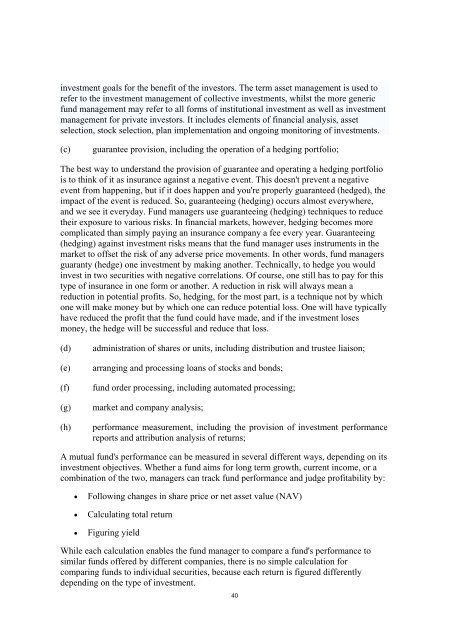taxud/2414/08 - European Commission - Europa
taxud/2414/08 - European Commission - Europa
taxud/2414/08 - European Commission - Europa
You also want an ePaper? Increase the reach of your titles
YUMPU automatically turns print PDFs into web optimized ePapers that Google loves.
investment goals for the benefit of the investors. The term asset management is used to<br />
refer to the investment management of collective investments, whilst the more generic<br />
fund management may refer to all forms of institutional investment as well as investment<br />
management for private investors. It includes elements of financial analysis, asset<br />
selection, stock selection, plan implementation and ongoing monitoring of investments.<br />
(c)<br />
guarantee provision, including the operation of a hedging portfolio;<br />
The best way to understand the provision of guarantee and operating a hedging portfolio<br />
is to think of it as insurance against a negative event. This doesn't prevent a negative<br />
event from happening, but if it does happen and you're properly guaranteed (hedged), the<br />
impact of the event is reduced. So, guaranteeing (hedging) occurs almost everywhere,<br />
and we see it everyday. Fund managers use guaranteeing (hedging) techniques to reduce<br />
their exposure to various risks. In financial markets, however, hedging becomes more<br />
complicated than simply paying an insurance company a fee every year. Guaranteeing<br />
(hedging) against investment risks means that the fund manager uses instruments in the<br />
market to offset the risk of any adverse price movements. In other words, fund managers<br />
guaranty (hedge) one investment by making another. Technically, to hedge you would<br />
invest in two securities with negative correlations. Of course, one still has to pay for this<br />
type of insurance in one form or another. A reduction in risk will always mean a<br />
reduction in potential profits. So, hedging, for the most part, is a technique not by which<br />
one will make money but by which one can reduce potential loss. One will have typically<br />
have reduced the profit that the fund could have made, and if the investment loses<br />
money, the hedge will be successful and reduce that loss.<br />
(d)<br />
(e)<br />
(f)<br />
(g)<br />
(h)<br />
administration of shares or units, including distribution and trustee liaison;<br />
arranging and processing loans of stocks and bonds;<br />
fund order processing, including automated processing;<br />
market and company analysis;<br />
performance measurement, including the provision of investment performance<br />
reports and attribution analysis of returns;<br />
A mutual fund's performance can be measured in several different ways, depending on its<br />
investment objectives. Whether a fund aims for long term growth, current income, or a<br />
combination of the two, managers can track fund performance and judge profitability by:<br />
• Following changes in share price or net asset value (NAV)<br />
• Calculating total return<br />
• Figuring yield<br />
While each calculation enables the fund manager to compare a fund's performance to<br />
similar funds offered by different companies, there is no simple calculation for<br />
comparing funds to individual securities, because each return is figured differently<br />
depending on the type of investment.<br />
40
















